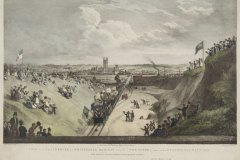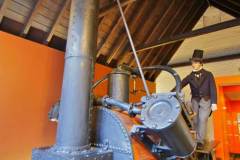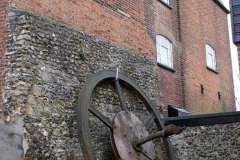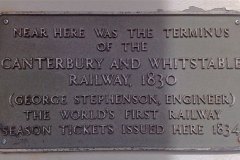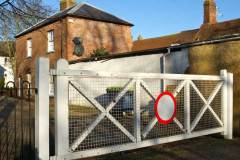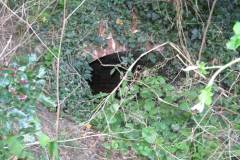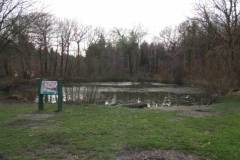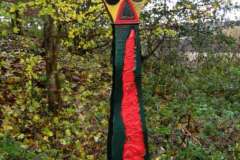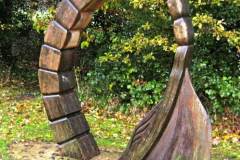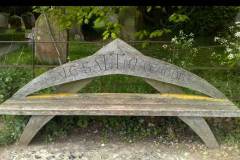Introduction
Canterbury has two notable railway records, the first scheduled commercial passenger service in the world and the first issue of season tickets. Both were the result of Victorian entrepreneurship and although the line closed many years ago some relics can still be seen along the route.
History
The Canterbury Rail Road company was formed in 1824 to create a new rail road between Canterbury and Whitstable because the River Stour had been silting up for many years and a new route to the sea was required. In 1825 an Act of parliament was given royal assent for a railway using the shortest but hilliest route was chosen. They engaged most celebrated engineers of their time. William James drew the plans, George and Robert Stephenson built the engine, Thomas Telford built the harbour at Whitstable and Brunel inspected the tunnel at Tyler Hill. Freight services started on 3rd May 1830 and the first passengers were carried the next day, making it the first scheduled commercial passenger service in the world (Image 1). Stationery steam winding engines pulled the train up and down the hills above Canterbury from a station in North Lane and the steam locomotive Invicta took over for the flat stretch along the top of the hills and down to Whitstable, although it quickly had to be supplemented with horses since it proved inadequate for the pull back out of Whitstable. A Sunday passenger service was opened in 1832 and two years later the first passenger “Season Tickets” in the world were issued for the period between 25th March and 1st November at a cost of two guineas. The same year substantial modifications to Invicta were carried out and a third winding engine was installed. The route was commercially unsuccessful and the line was leased out in 1836. Despite offering a steamer service from Whitstable harbour to London Bridge and operating with winding engines only, the company went bankrupt and was handed back to the original owners in 1939. In 1844 Canterbury was linked to London via Ashford by the South Eastern (SER) Railway who leased and subsequently purchased the line, replaced the winding engines with steam locomotives with lowered funnels and moved the terminus to the newly constructed Canterbury West Station. In 1860 the rival London, Chatham and Dover Railway (LC&DR) opened Canterbury East Station, providing a much quicker routes to London and the importance of Canterbury as a staging post to the continent declined. The line was then used only for local traffic and from 1916 competition from bus services started. Rail passenger services were withdrawn from 1931 and following the nationalisation under British Rail in 1948 the last freight train operated on 1 December 1952 and the track and infrastructure were removed in 1953.
The Crab and Winkle Line Trust (http://www.crabandwinkle.org/) was set up on the 3rd May 1997 to promote public access along the route of the railway line. In 1999 a 7 mile footpath and cycleway, the “Crab and Winkle Way” opened incorporating part of original trackbed with interpretive panels and works of art along the route. The way also forms part of Route 1 of the National Cycle Network (http://www.sustrans.org.uk/sustrans-near-you/south-east/easy-rides-in-the-south-east/crab-and-winkle-way). The Kentish Stour Countryside Trust publishes a comprehensive leaflet on the Way (http://www.kentishstour.org.uk/C&W_way_lflt.htm) which can be downloaded on line.
What to see
- Invicta was exhibited at railway exhibitions until donated to the city in 1906 from when it was exhibited just outside Riding Gate until 1968 when it was moved to Dane John Gardens. Since its restoration at the National Rail Museum at York in 1999 it has been on exhibition at the Canterbury Museum at Poor Priests (Image 2).
- The wheel of a winding engine can now be seen in Gas Road leaning against a decommissioned oast house (Image 3)
- A plaque recording that the first season tickets in the world were issued there could be seen at Canterbury West Station until its refurbishment in 2010 (Image 4).
- A level crossing gate still marks the site of the original terminus, which later became the goods and coal yard, in North Lane (Image 5).
- Along the Crab & Winkle Way relics of the railway can still be found, including a pre 1830 footpath arch in the suburbs of Canterbury (Image 6) and a winding engine pond in Clowes Wood (Image 7).
- Wayfinding and artwork have also been added to the Way (Images 8 -10).
Sources: Maxted (1970); Ratcliffe (1980); Hart (1991); Page (2000) ;Oppitz (2003); Ellis (1980)

